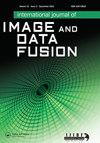鲸鸦搜索优化使深度卷积神经网络用于洪水检测
IF 1.8
Q3 REMOTE SENSING
International Journal of Image and Data Fusion
Pub Date : 2023-03-16
DOI:10.1080/19479832.2023.2186957
引用次数: 0
摘要
摘要卫星图像在洪水探测领域受到越来越多的关注。对于紧急情况下的规划行动,洪水探测发挥着至关重要的作用,但主要障碍是使用卫星图像来探测洪水地区。对于洪水检测,该方法在深度卷积神经网络(W-CSA-DCNN)方法的基础上创新了一种名为Whale-crow-搜索算法的模型。预处理、分类、分割和特征提取是该模型的四个步骤。为了从输入图像中初步获得声音和年代,对卫星图像进行预处理,然后根据植被指数对预处理后的图像进行特征提取。利用核模糊自回归(KFAR)模型,将获取的特征用于分割过程。在获得分段后,对其进行分类,该分类通过DCNN进行,并通过作为Crow搜索算法(CSA)和Whale优化算法(WOA)的组合的W-CSA进行良好的限定。基于0.982、0.972和0.975值的特异性、准确性和敏感性,该工艺的效率考虑了比现有工艺更先进的性能。本文章由计算机程序翻译,如有差异,请以英文原文为准。
Whale- crow search optimisation enabled deep convolutional neural network for flood detection
ABSTRACT The satellite images are more attracted in the field of flood detection. For planning actions during emergencies, flood detection plays a vital role, but the major barrier is that using satellite images to detect flooded regions. For flood detection, this method innovates a model named Whale-crow search algorithm on the basis of deep convolutional neural network (W-CSA DCNN) approach. Pre-processing, classification, segmentation and feature extraction are the four steps which is included in this model. For obtaining sound and antiquity from the input image initially, the satellite imagery is given to pre-processing and then for obtaining the features on the basis of vegetation indices the pre-processed image is put through the feature extraction process. By means of Kernel Fuzzy Auto regressive (KFAR) model, the acquire features are subsequently used in the segmentation process. After obtaining the segments, it is given to the classification, which is carried out by means of DCNN and qualified excellently via the W-CSA that is the combination of the Crow Search Algorithm (CSA) and Whale optimisation algorithm (WOA). Based on the specificity, accuracy and sensitivity with values 0.982, 0.972 and 0.975, the efficiency of this process deliberates advanced performance than the existing process.
求助全文
通过发布文献求助,成功后即可免费获取论文全文。
去求助
来源期刊

International Journal of Image and Data Fusion
REMOTE SENSING-
CiteScore
5.00
自引率
0.00%
发文量
10
期刊介绍:
International Journal of Image and Data Fusion provides a single source of information for all aspects of image and data fusion methodologies, developments, techniques and applications. Image and data fusion techniques are important for combining the many sources of satellite, airborne and ground based imaging systems, and integrating these with other related data sets for enhanced information extraction and decision making. Image and data fusion aims at the integration of multi-sensor, multi-temporal, multi-resolution and multi-platform image data, together with geospatial data, GIS, in-situ, and other statistical data sets for improved information extraction, as well as to increase the reliability of the information. This leads to more accurate information that provides for robust operational performance, i.e. increased confidence, reduced ambiguity and improved classification enabling evidence based management. The journal welcomes original research papers, review papers, shorter letters, technical articles, book reviews and conference reports in all areas of image and data fusion including, but not limited to, the following aspects and topics: • Automatic registration/geometric aspects of fusing images with different spatial, spectral, temporal resolutions; phase information; or acquired in different modes • Pixel, feature and decision level fusion algorithms and methodologies • Data Assimilation: fusing data with models • Multi-source classification and information extraction • Integration of satellite, airborne and terrestrial sensor systems • Fusing temporal data sets for change detection studies (e.g. for Land Cover/Land Use Change studies) • Image and data mining from multi-platform, multi-source, multi-scale, multi-temporal data sets (e.g. geometric information, topological information, statistical information, etc.).
 求助内容:
求助内容: 应助结果提醒方式:
应助结果提醒方式:


